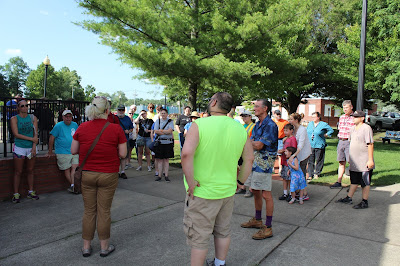Hello! I’m DJ Kraai, a previous Fort St.
Joseph (FSJ) field school student and Western Michigan University graduate.
I’ve enjoyed following the FSJ project over the past few years and wanted to
write back to share my experience becoming a full-fledged archaeologist.
I graduated in April 2017 and took a full time
job in employment services. After a few short months I grew tired of the daily
office grind and dreamt of being in the field once again. With the help of Dr.
Michael Nassaney, Erika Hartley, and Tim Bober I updated resume and began
searching for employment as an archaeologist.
In the spring of 2018 I received an internship
in New Mexico on a Pueblo I,II,III (750 - 1300 A.D.) site excavation. I
revealed a stone masonry roomblock adjacent to a Great Kiva and earned the
right to excavate within the kiva itself, a task not normally given to the
interns. Thankfully I had learned excellent excavation technique during my time
with the FSJ field school and my accurate note taking, clear drawings, and linear
walls were quickly recognized. My internship ended as Fall 2018 began.
I briefly returned to Michigan before
accepting a temporary archaeological field technician position on a 30,000 acre
pedestrian survey project throughout Northern and Western Arizona. My
significant other still held employment in Michigan and we didn’t want to pay
for two homes so I pulled the front seat out of my Subaru Forester, hammered
together some plywood, and inserted a makeshift bed. For the next 3 months I
lived out of my car and slept on public Forest Service land, which is not
entirely uncommon for field techs to do. Many archaeology projects are in
remote areas so camping on-site for 8 day periods is a common practice. Since I
was already camping for work I just extended my off-road living into my 6 day
breaks between sessions.
I returned to Michigan once the winter was in
full swing and we were unable to continue surveying due to snow (who knew it
snowed in Arizona!). My partner and I packed up, hopped in the car, and I made
my final three-day drive to the Southwest (I had driven between Michigan and
New Mexico/Arizona three times and flown twice by now) to set up our new home
in Phoenix, Arizona. I chose Phoenix due to the incredible amount of
archaeology employment opportunities in the area. Archaeology is largely driven
by the oil, natural gas, and forestry industries due to Section 106 of the
National Historic Preservation Act, which dictates that any time an undertaking
is located on federal property or receives federal monies the client must
assess if there will be an adverse effect on historic properties. This often
requires an archaeological assessment to be done of the affected area.
Once located in Phoenix I immediately found
myself inundated with temporary job offers. There are many Cultural Resource
Management (CRM) firms throughout the United States. Each of these firms bid on
projects that require archaeological survey or data recovery work to be done.
Since the firms’ employment needs vary with the projects they recieve it is
normal for archaeological field technicians to be hired on a temporary basis
and then jump between multiple companies throughout the year as projects begin
and end.
For the next few months I did just that. I had
phenomenal experiences getting to work throughout the Southwest’s many
environments and saw an unbelievable amount of archaeology. As my experience
and network grew I took a shot at a full-time archaeologist position and
received the position. While I’ll still spend most of my time in the field I
now have the opportunity to continue projects into the office phase to complete
reports and further my competencies.
Thank you all for reading my story! I hope it
shed some light on the journey between field school student and archaeologist.















